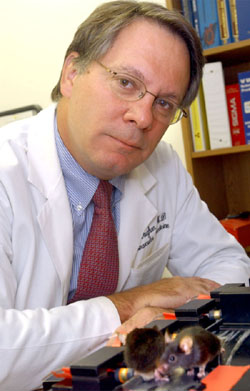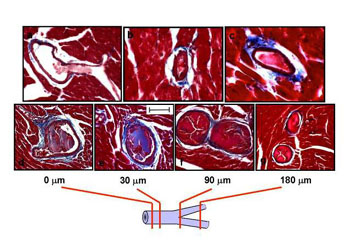
Dr. Douglas E. Vaughan, C. Sidney Burwell Professor of Medicine and professor of Pharmacology, has spent the last 10 years focusing on the role of the protein plasminogen activator inhibitor-1 (PAI-1) in cardiovascular disease.
21st century heart attack risk factor examined at VUMC

Examples (A-C) of coronary arterial thromboses, or clots, in transgenic mice that overexpress a stable form of PAI-1. Panels D-G depict cross sections along a thrombosed coronary artery, as schematically illustrated below the images. The clotting extends the length of the main artery and into each of the branching vessels.
In today’s fast-food society with a penchant for supersized fries and Big Gulp soft drinks, where 60 percent of the population is overweight and 30 percent is classified as obese, the risk of heart attack is increasing along with our waistlines. Age and excessive weight can be a lethal combination as coronary arteries become blocked, triggering a heart attack. And, it turns out, the oft-cited culprit cholesterol is not always at fault.
A group of Vanderbilt researchers, led by Dr. Douglas E. Vaughan, C. Sidney Burwell Professor of Medicine and professor of Pharmacology, has spent the last 10 years focusing on the role of the protein plasminogen activator inhibitor-1 (PAI-1) in cardiovascular disease. In a recent article in the journal Circulation, the group reported the creation of a unique strain of mice that overproduces the human PAI-1 protein, which results in coronary artery clotting and heart attack in the mice.
“This protein is emerging as a 21st century risk factor for heart disease,” Vaughan said. “We think the model is a unique platform for understanding not only the role of PAI-1 in cardiovascular disease, but also for potentially testing the first generation of inhibitors of PAI-1 that are being developed as potential agents in prevention of heart attacks.”
PAI-1 is an important element in the body’s natural system for preventing clots within blood vessels. The system reflects a fine balance between the opposing forces known as plasminogen activators, which act as anticoagulants, and plasminogen activator inhibitors, which promote clotting. These short-lived proteins are synthesized in the blood vessel walls and circulate in low concentrations in the blood, cooperating to ensure clotting happens only when and where it is needed. Levels of PAI-1 are known to be higher in individuals who are overweight. Its production is triggered by many factors associated with obesity, including high glucose, insulin, triglycerides, and angiotensin II.
Vaughan and then post-doctoral fellow Mesut Eren (now a research assistant professor in Medicine) engineered a strain of mice that overexpresses a form of human PAI-1 that is longer-lived than the natural protein, providing a larger window in which to study its function. The transgenic mice have a few noticeable effects: they’re bald, they have enlarged spleens and livers, and their blood production occurs in the spleen, rather than the bone marrow.
But the most exciting thing from a cardiovascular point of view, Vaughan says, is that, as they age, about half the mice spontaneously form clots in their coronary arteries, without evidence of hypertension, atherosclerosis, or high lipid levels.
“It’s really hard to make a mouse have a heart attack,” Vaughan said. “You can make mice very hypercholesterolemic and they are great models of atherosclerosis, but they don’t develop coronary clots. I think this is saying that in a mammal, it’s enough to have a high PAI-1 level to precipitate the clotting of the coronary arteries and a heart attack.”
In these mice the clots occur predominantly in the arterial vessels, and not in the venous system. According to Vaughan, this observation resonates with a theory put forth in the New England Journal of Medicine in 1999 by Robert Rosenberg of Beth Israel Hospital suggesting that there are different anti-coagulant mechanisms in different vascular beds in the body. So, for instance, the brain has a different system from the heart, which is different from the liver. Because PAI-1 has the power to inhibit all three of the major anticoagulant systems in the coronary arteries, that could explain why the mice are experiencing selective clotting there.
Other groups have tried to create transgenic mice overexpressing PAI-1 with different results. In a 1990 article in the journal Nature, scientists at Upjohn Pharmaceutical described transgenic mice made to overexpress human PAI-1 using a liver-specific promoter. The mice had unusual, hypercellular clots in the tail vein and footpads, and the effect was ephemeral; after several weeks, the mice stopped producing PAI-1 and normalized.
Another PAI-1 transgenic, this one engineered by a group of scientists at the University of Michigan in 1996, made use of a viral promoter to overexpress native mouse PAI-1 protein. The protein was produced in high levels and in every tissue, throughout the animal, but the investigators reported no evidence of clotting.
Vaughan’s group used a promoter that preferentially drives PAI-1 expression in the arteries, and that could be part of why they see clotting there, he says. And, he believes, the fact that a human protein is being expressed in the mouse shouldn’t affect function, since the part of the protein that binds with and inhibits plasminogen activator is conserved between mouse and human. Why the effect happens only with aging in the mice and not at the beginning of life is uncertain. Vaughan suspects that there is a natural aging process of the vascular system, and that superimposing on that process the overexpression of PAI-1 is enough to tip the scales and cause the clotting.
Ongoing and future experiments will test ways to accelerate arterial clotting in the transgenic mice. If the mice are made hypertensive or hypercholesterolemic, do the clots appear earlier? The investigators are also looking to see if the first generation of drugs that inhibit PAI-1 can prevent clotting.
The work published in Circulation was supported by grants from the NIH and by a Geriatric Research Educational Clinical Center grant from the Department of Veteran Affairs. Other Vanderbilt researchers who participated include Corrie Painter and Dr. James Atkinson.













